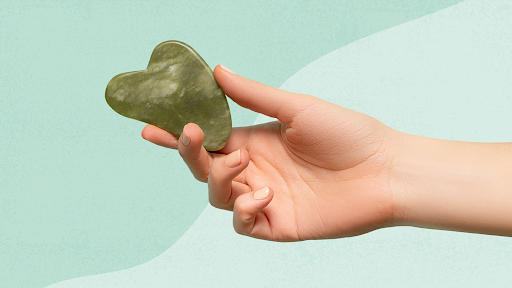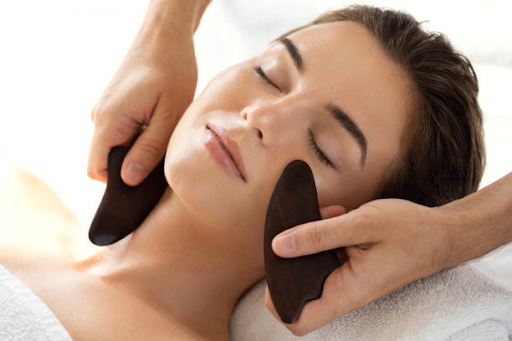Gua Sha: Discovering the Ancient Origins and Secrets of the Healing Art

The Ultimate Guide to Gua Sha: Benefits, Techniques, and How to Get Started
January 22, 2025
Hamilton Rotte, AP
June 13, 2025Gua Sha is an ancient healing practice that has captivated wellness enthusiasts worldwide. It involves gently scraping the skin with specialized tools to promote healing and restore balance to the body.
The Origins of Gua Sha
Gua Sha originated from the wisdom of ancient Chinese healers thousands of years ago. They discovered its remarkable ability to:
- Release muscle tension
- Enhance blood circulation
- Support lymphatic drainage
- Reduce inflammation
- Promote natural healing responses
Gua Sha Today
The practice has evolved beyond its traditional roots and is now a popular treatment in modern wellness circles. Its versatility has made it suitable for various applications, such as:
- Facial rejuvenation
- Deep tissue therapy
Gua Sha’s effectiveness has earned it a permanent place in both clinical settings and home care routines.
Gua Sha at Cho Acupuncture and Herbal Clinic
At Cho Acupuncture and Herbal Clinic, our skilled practitioners preserve the authentic techniques of Gua Sha while incorporating contemporary understanding of its therapeutic benefits. This harmonious blend of ancient wisdom and modern expertise ensures optimal results for our patients seeking natural healing solutions.
To explore more about our services, including Gua Sha, you can fill out our forms for a consultation or treatment. We also have a dedicated section on conditions we treat, which includes various ailments that can be effectively managed through our holistic approach. For further insights into Gua Sha and other aspects of Traditional Chinese Medicine, feel free to browse through our informative blog.
The Rich History of Gua Sha in Traditional Chinese Medicine
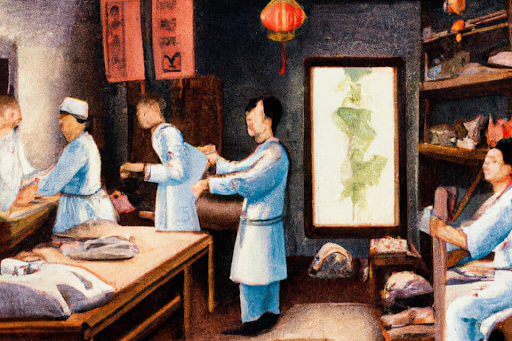
Gua Sha has a long and fascinating history in Traditional Chinese Medicine (TCM). Its origins can be traced back thousands of years, with evidence suggesting its use during the Paleolithic Age when early humans used stone tools for various purposes.
Ancient Evidence and Written Records
The earliest documented evidence of Gua Sha comes from the Paleolithic Age, where stone tools resembling modern Gua Sha instruments were found. During the Ming Dynasty (1368-1644), written records provide detailed descriptions of “Gua Sha” as a systematic healing method, although the practice existed long before it was formally documented.
Classical Terms Used in TCM
Ancient TCM texts describe Gua Sha using several classical terms:
- “Coining” (銅錢刮痧) – referring to the use of copper coins
- “Scraping” (刮痧) – describing the fundamental technique
- “Spooning” (匙療法) – noting the traditional use of soup spoons
The Shang Han Lun, an important TCM text from the Han Dynasty (206 BCE-220 CE), mentions therapeutic scraping techniques that align with Gua Sha principles. These ancient practitioners believed that illness was caused by stagnant qi and blood, which could be released through specific scraping patterns.
Healing Properties Attributed to Gua Sha
Traditional Chinese medicine attributed several healing properties to Gua Sha:
Expelling Pathogenic Factors
- Release of “sha” (瘀血) or stagnant blood
- Elimination of wind-heat patterns
- Clearing of toxic heat
Restoring Balance
- Regulating qi flow through meridian channels
- Harmonizing yin and yang energies
- Supporting proper organ function
Primary Treatments for Common Ailments
Ancient physicians used Gua Sha as a primary treatment for:
- Febrile conditions
- Respiratory ailments
- Digestive disorders
- Musculoskeletal pain
The practice became particularly important during epidemics when it was used to treat infectious diseases. Historical records from various Chinese provinces document its effectiveness in managing cholera outbreaks and seasonal illnesses.
Authentic Gua Sha Treatments at Cho Acupuncture and Herbal Clinic
For those seeking genuine Gua Sha treatments, Cho Acupuncture and Herbal Clinic offers specialized services. Their approach is deeply rooted in traditional practices, ensuring effective and safe treatment. You can discover more about their comprehensive offerings, including Cupping therapy, on their website. The clinic’s founder possesses extensive experience in this field, which you can further explore on their About Me page.
Cultural Significance and Evolution of Gua Sha Techniques
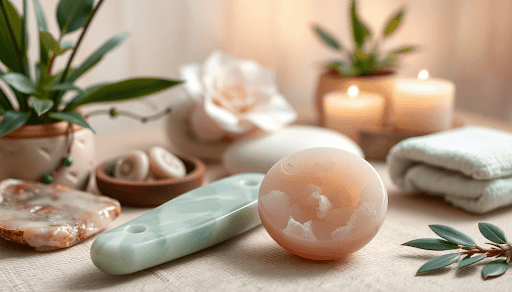
Gua Sha’s cultural significance extends far beyond its healing properties, deeply embedded in Chinese family traditions and social practices. In ancient households, the practice symbolized familial care and community bonding, with knowledge passed down through generations as a cherished cultural inheritance.
Regional Variations and Cultural Adaptations
The practice evolved distinctly across different regions, each developing unique approaches based on local customs and environmental factors:
- Northern China: Practitioners traditionally used coins and ceramic spoons, focusing on treating cold-induced ailments.
- Southern China: Jade tools became prominent, with techniques adapted for humid climate conditions.
- Southeast Asian Communities: Integration of local healing herbs and oils with Gua Sha practices.
Vietnamese communities incorporated cao gio, their variation of Gua Sha, emphasizing wind-related illnesses. Indonesian traditions merged Gua Sha with their native healing practices, creating distinctive therapeutic approaches.
Social and Spiritual Dimensions
Traditional Gua Sha sessions often served as social gatherings, strengthening community bonds. The practice carried spiritual significance:
- Believed to balance yin and yang energies
- Connected to ancestral wisdom and respect
- Integrated into seasonal wellness rituals
- Associated with spiritual cleansing practices
Modern Cultural Adaptations
Contemporary Gua Sha has undergone significant evolution while maintaining its cultural essence:
- Integration with modern wellness practices
- Development of specialized tools for specific treatments
- Adaptation of techniques for various skin types and conditions
- Incorporation into professional healthcare settings
The practice now bridges traditional wisdom with contemporary healthcare needs, reflecting its adaptability while preserving its cultural authenticity. Different cultures have embraced and modified Gua Sha techniques, creating a rich tapestry of healing practices that honor its Chinese origins while accommodating diverse cultural perspectives. This adaptability is evident in its integration with modern wellness practices such as acupuncture therapy, which shares similar holistic principles.
The Science Behind Gua Sha: Mechanisms of Healing Revealed
Modern scientific research has unveiled fascinating insights into the physiological mechanisms behind Gua Sha’s therapeutic effects. The practice triggers multiple healing responses within the body through specific biological pathways.
Key Physiological Responses:
Microcirculation Enhancement
- Blood flow increases up to 400% in treated areas
- Oxygen delivery to tissues improves significantly
- Nutrient transport accelerates cellular repair
Anti-Inflammatory Action
- Heme-oxygenase-1 enzyme production increases
- Pro-inflammatory cytokines decrease
- Natural anti-inflammatory compounds release
The controlled pressure and scraping motions of Gua Sha create a therapeutic response called petechiae – tiny spots that appear on the skin’s surface. This response:
- Breaks down scar tissue
- Releases muscle adhesions
- Stimulates lymphatic drainage
Neurological Impact:
- Activates the parasympathetic nervous system
- Reduces cortisol levels
- Promotes relaxation response
- Decreases muscle tension
Research has documented significant improvements in conditions such as:
- Chronic neck pain
- Migraine headaches
- Perimenopausal symptoms
- Hepatitis B
- Breast engorgement
The mechanical stress applied during Gua Sha triggers mechanotransduction – a process where physical forces convert into biochemical signals. This cellular-level response activates healing mechanisms throughout the body’s tissues.
Recent studies using thermal imaging have shown that Gua Sha’s effects persist for days after treatment, maintaining increased microcirculation and reduced inflammation in treated areas. These findings explain the long-lasting relief many patients experience following sessions at Cho Acupuncture and Herbal Clinic.
Ancient Tools and Materials Used in Gua Sha Practice
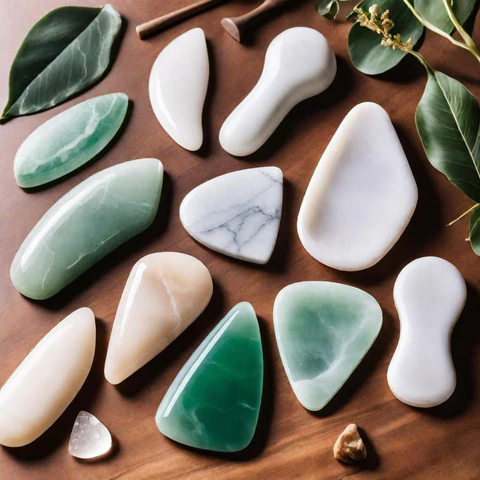
Traditional Gua Sha practitioners carefully selected their tools based on specific healing properties and cultural significance. Each material carries unique energetic qualities that enhance the therapeutic experience:
1. Jade Tools
- Natural jade stones possess cooling properties
- Believed to balance qi and draw out negative energy
- Smooth, dense structure ideal for gentle scraping motions
- Traditional symbol of purity and healing in Chinese culture
2. Buffalo Horn
- Prized for its ability to disperse heat from the body
- Natural curves perfectly conform to body contours
- Historically used for treating fever and inflammation
- Represents strength and endurance in ancient practices
3. Rose Quartz
- Known for its gentle, nurturing energy
- Used primarily for facial treatments
- Aids in lymphatic drainage
- Connected to heart meridians in TCM
4. Ceramic Spoons
- Common household items adapted for healing
- Glazed surface allows smooth, controlled movements
- Different sizes target various body areas
- Accessible to all social classes in ancient times
5. Bian Stone
- Contains trace minerals beneficial for healing
- Naturally formed through lightning strikes
- Emits ultrasound pulsations during use
- Sacred stone in traditional Chinese medicine
The material selection process reflects both practical considerations and energetic properties. Ancient practitioners understood that different tools created varying levels of pressure and stimulation, allowing for customized treatments based on individual needs and conditions.
Gua Sha Through Time: From Ancient Rituals to Modern Adaptations
Ancient Chinese beauty rituals embraced Gua Sha as a transformative practice, extending beyond its therapeutic applications. Palace records from the Ming Dynasty reveal imperial concubines using jade tools to maintain their youthful appearance, believing in the stone’s ability to balance qi and preserve beauty.
Traditional Beauty Applications:
- Gentle scraping motions along facial meridians
- Regular treatments to enhance skin luminosity
- Specific techniques for addressing aging concerns
- Integration with herbal facial masks and oils
The practice spread throughout Asia, with each region developing unique beauty protocols. Korean nobility adopted Gua Sha into their elaborate skincare routines, while Vietnamese practitioners combined it with local herbal preparations.
Modern Facial Gua Sha Innovations:
- Specialized facial tools designed for delicate areas
- Integration with contemporary skincare products
- Targeted techniques for lymphatic drainage
- Adaptation for various skin types and concerns
Today’s facial Gua Sha incorporates scientific understanding with traditional wisdom. Modern practitioners use precise pressure points and scientifically-backed movements to:
- Reduce facial tension
- Minimize fine lines
- Enhance natural contours
- Improve product absorption
- Stimulate collagen production
The beauty industry has embraced Gua Sha, creating specialized tools and protocols. Aestheticians combine ancient techniques with modern skincare science, developing treatments that address contemporary beauty concerns while honoring traditional principles.
Luxury spas now offer customized Gua Sha facial treatments, incorporating:
- LED light therapy
- Cryotherapy elements
- Advanced facial mapping
- Precision pressure techniques
This evolution demonstrates Gua Sha’s remarkable adaptability, transforming from palace beauty secrets to a cornerstone of modern skincare routines. The practice maintains its core principles while embracing scientific advances and contemporary beauty needs.
Cultural Perspectives on Gua Sha: Misconceptions and Appreciation
The rising popularity of Gua Sha has sparked both interest and misunderstandings about this ancient healing practice. Social media’s portrayal often reduces this rich therapeutic tradition to mere aesthetic benefits, overlooking its profound cultural significance and healing properties.
Common Misconceptions About Gua Sha:
- “It’s just another beauty trend” – While facial Gua Sha has gained popularity in skincare routines, the practice’s primary purpose lies in its therapeutic applications for whole-body wellness
- “The red marks indicate damage” – These marks, known as ‘sha’, are actually signs of improved blood flow and the release of stagnant energy
- “Anyone can practice it without training” – Traditional Gua Sha requires proper technique and understanding of meridian pathways
Cultural Heritage and Authenticity
Gua Sha’s roots trace back generations of Chinese families who passed down this healing wisdom. The practice embodies core principles of Traditional Chinese Medicine:
- Balance of Yin and Yang
- Movement of Qi (energy)
- Harmony between body systems
Authentic Gua Sha treatments at clinics like Cho Acupuncture preserve these traditional elements while adapting to modern healthcare needs. Practitioners combine ancient wisdom with contemporary understanding of anatomy and physiology.
Appreciating Cultural Context
Understanding Gua Sha requires acknowledging its place within Chinese medicine’s holistic approach to health. The practice represents:
- Intergenerational knowledge transfer
- Traditional healing philosophies
- Cultural values around community wellness
Recognizing these deeper aspects helps preserve the integrity of Gua Sha while making its benefits accessible to diverse communities seeking natural healing methods.
Incorporating Gua Sha into Your Wellness Routine: A Holistic Approach
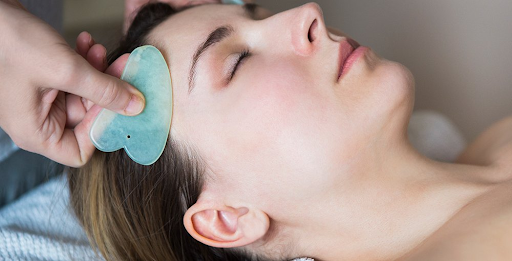
Creating a sustainable Gua Sha practice requires thoughtful integration into your existing wellness routine. Here’s a comprehensive guide to establishing an effective Gua Sha ritual:
Daily Practice Guidelines
- Start with 5-10 minutes in the morning or evening
- Practice on clean, oil-prepped skin
- Use gentle to moderate pressure
- Follow lymphatic drainage patterns
- Maintain consistent strokes (15-20 per area)
Essential Preparation Steps
- Cleanse skin thoroughly
- Apply facial oil or serum
- Hold tool at 15-45 degree angle
- Breathe deeply throughout practice
- Stay hydrated before and after
Complementary Treatments
Gua Sha’s effectiveness multiplies when combined with other healing modalities:
- Acupuncture sessions – enhances qi flow and energy balance
- Herbal medicine – supports internal healing processes
- Cupping therapy – deepens tissue release
- Mindful meditation – amplifies stress-reduction benefits
Weekly Schedule Template
Monday: Face and neck Gua Sha Wednesday: Full body treatment Friday: Targeted problem areas Weekend: Rest and recovery
Signs of Progress
- Reduced facial puffiness
- Improved muscle tension
- Enhanced skin clarity
- Better circulation patterns
- Decreased stress levels
For optimal results, schedule professional Gua Sha treatments at licensed practitioners like Cho Acupuncture and Herbal Clinic between self-care sessions. Their expertise ensures proper technique and maximizes therapeutic benefits through integrated TCM approaches.
Conclusion: Embracing the Timeless Wisdom of Gua Sha for Modern Well-Being
Gua Sha is a shining example of the lasting power of traditional healing practices. This ancient technique combines centuries of knowledge with today’s wellness needs, providing deep benefits for those seeking better health. Its ability to adapt across cultures and eras proves its fundamental effectiveness in promoting healing and well-being.
The beauty of Gua Sha lies in its:
- Accessibility to practitioners of all skill levels
- Integration with both traditional and modern healing methods
- Ability to address multiple aspects of health simultaneously
As we navigate the complexities of modern life, Gua Sha provides a grounding connection to time-tested healing wisdom. At Cho Acupuncture and Herbal Clinic, we witness daily how this ancient practice transforms lives, merging traditional techniques with contemporary understanding to create powerful healing experiences.
The journey of Gua Sha continues to evolve, yet its core principles remain unchanged – a reminder that true healing wisdom transcends time.


